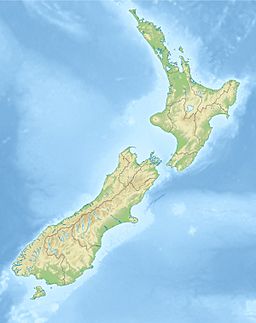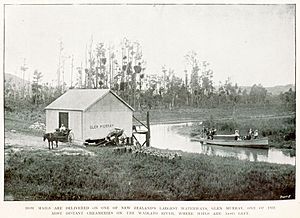Lake Opuatia facts for kids
Quick facts for kids Lake Opuatia |
|
|---|---|
| Location | Waikato District, Waikato region, North Island |
| Coordinates | 37°26′7.2″S 175°03′48.3″E / 37.435333°S 175.063417°E |
| Lake type | peat lake |
| Basin countries | New Zealand |
| Surface area | 7 ha (17 acres) |
| Surface elevation | 5 m (16 ft) |
Lake Opuatia is a small lake found within the much larger Opuatia wetland. This wetland drains into the Waikato River from the west. The lake is located at the end of a long valley that the Opuatia Stream flows through.
 |
Port Waikato | Pukekawa | Rangiriri |  |
| Limestone Downs | Waikato River | |||
| Te Akau | Lake Whangape | Huntly |
Contents
How Lake Opuatia Was Formed
Lake Opuatia is a special type of lake called a peat lake. It likely formed about 1,800 years ago. This happened when a huge amount of ash and rock, called Taupo pumice, flowed down the Waikato River from the Taupo Volcano. This material blocked the valley's natural drainage, causing water to build up and create the lake.
The History of Lake Opuatia
The area around Lake Opuatia was once home to the Māori tribes of Ngāti Karewa and Ngāti Tipa. Even though these tribes were loyal to the government during the Invasion of the Waikato in 1863, much of their land was still taken away. Later, some land was given back to members of Ngāti Tipa, but arguments about who owned the land continued until 1921.
To help people settle in the area, the government started building a special path called a bridleway. This path was for horses and people. It started at Churchill, a settlement on the west side of the Waikato River. By 1881, about 16 kilometers (10 miles) of this path south of the lake had been opened. By 1883, a full track connected the Waikato River all the way to the West Coast. In 1894, people suggested building a wider road, about 3.6 meters (12 feet) wide. Growing flax was an important local business for a while.
In 1894, there was a disagreement when the government tried to build Opuatia Road on Māori land. Survey markers were removed by local people. The police, with armed support, arrested 10 men and 8 women. Two of these people were sentenced to two months of hard work. The government later bought a large area of land, about 11,090 hectares (27,407 acres), in 1895. By the 1920s, the roads in the valley were being covered with metal to make them stronger.
Local Schools and Community
In the past, there were schools near Lake Opuatia. One was at Churchill, just east of the lake. Another was at Orton, about 6 kilometers (3.7 miles) north. There was also a school on Otuiti Road at Opuatia. Opuatia school opened in 1917 with 20 students and closed in 1973. Today, it is used as a community center. A telephone line was connected to the area in 1919. There was also a church in the 1850s.
Wildlife Around Lake Opuatia
Lake Opuatia and its surrounding wetlands are home to many different plants and animals.
Aquatic Plants in the Lake
The last time the lake's plants were studied was in 1993. At that time, four types of plants that grow underwater were found. These included fennel leaved pondweed, Potamogeton crispus, and P. pectinatus. Sometimes, special algae called charophytes (Nitella hookeri and Chara corallina) were also seen.
Fish in the Lake
Longfin eels have been found living in Lake Opuatia.
Plants Near the Lake's Edge
The lake is surrounded by a large wetland area, covering about 950 hectares (2,347 acres). About 180 hectares (445 acres) of this is a peat bog, which is a very wet, spongy area made of decaying plants. The rest is swamp and fen, which are also wet areas. These areas are mostly covered by willow trees and manuka bushes. There are also rare restiad bogs.
Underneath the taller plants, you can find native sedges, Nertera scapanioides, Microtis unifolia, and ferns like matua-rarauhe and kiokio. At the edges of the lake, you'll see raupo (a type of bulrush).
Some unwanted plants, called weeds, are also present. These include gorse, reed sweet grass, reed canary grass, swamp alder, yellow flag iris, beggarticks, and royal fern. Animal pests like possums and red deer also live here. Some rare plants, such as orchids and carnivorous bladderworts, can also be found.
Birds of Lake Opuatia
Many different birds have been seen in the Lake Opuatia area. These include Canada gooses, fernbirds, yellowhammers, chaffinches, riroriros, swallows, pheasants, pukekos, mallard ducks, harriers, and shags. The lake has been a popular spot for duck hunters since at least 1921.
Protecting and Restoring the Lake
In 2000, the Regional Council decided to help the Opuatia Wetland. They wanted to make up for the effects of flood protection work nearby. Their plan was to restore the wetland and allow about 60 hectares (148 acres) to flood more often.
Starting in 2006, they sprayed gorse and willow trees with special chemicals to remove them. Then, they planted many native trees and plants. These included cabbage trees, karamu, manuka, mingimingi, poataniwha, Coprosma rhamnoides, pokaka, flax, Astelia grandis, gahnia, Coprosma tenuicaulis, kahikatea, and matai. Since then, another 10,000 plants have been added. This planting helps reduce the amount of nutrients flowing into the wetland from nearby farms, which keeps the water cleaner.
Opuatia Stream
Interestingly, the Opuatia Stream flows near the lake, but there is no direct connection between the lake and the stream on the surface. The lake and the bog usually get their water from rain. However, during very big floods, water from the Waikato River can flow backward and reach the lake.
The Opuatia Stream starts near Ponganui Road, about 30 kilometers (18.6 miles) upstream from the lake. There is a place about 8 kilometers (5 miles) from where the stream begins where they check the water quality. The water here is often in the worst 25% compared to similar streams for things like bacteria, how clear it is, and nitrogen levels. To make the water cleaner, people have been planting trees, putting up fences, and controlling goats in the upper part of the stream's catchment area, which covers about 18,251 hectares (45,099 acres).
The stream used to be deep enough for boats to travel about 8 kilometers (5 miles) up to Glen Murray landing. This landing was built around 1895, and Opuatia even had a post office there in 1911.



